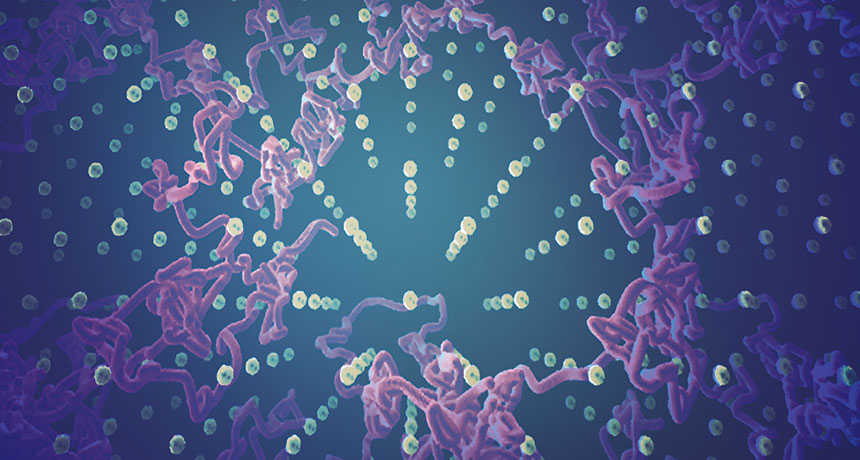Laser experiment hints at weird in-between ice

A proposed form of ice acts like a cross between a solid and a liquid. Now, a new study strengthens the case that the weird state of matter really exists.
Hints of the special phase, called superionic ice, appeared in water ice exposed to high pressures and temperatures, researchers report February 5 in Nature Physics. Although such unusual ice isn’t found naturally on Earth, it might lurk deep inside frozen worlds like Uranus and Neptune (SN Online: 3/5/12).
Normal ice is composed of water molecules, each made of an oxygen atom bonded to two hydrogen atoms. As water freezes, those molecules link up to form a solid. But superionic ice is made up of ions, which are atoms with a positive or negative electric charge. Within the material, hydrogen ions flow freely through a solid crystal of oxygen ions.
“That’s really strange behavior for water,” says study coauthor Marius Millot, a physicist at Lawrence Livermore National Laboratory in California. Although the superionic state was first predicted 30 years ago, “up until now we didn’t really know whether this was something that was real.”
At extremely high pressures, familiar substances like water can behave in unusual ways (SN: 1/14/12, p. 26). Working with a sample of ice that was crushed between two diamonds, Millot and colleagues used a laser to create a shock wave that plowed through the ice, boosting the pressure even more. At first, the density and temperature of the ice ramped up smoothly as the pressure increased. But at around 1.9 million times atmospheric pressure and 4,800 kelvins (about 4,500° Celsius), the scientists observed a jump in density and temperature. That jump, the researchers say, is evidence that superionic ice melted at that point. Although we normally think of ice as being cold, at high pressures, superionic ice can form even when heated. The melting occurred at just the conditions that theoretical calculations predict such ice would melt. The physicists didn’t measure the pressure at which the superionic phase first formed.
The electrical conductivity of the material provided another hint of superionic ice: The level of conductivity was consistent with expectations for that phase of matter. Whereas metals conduct electricity via the motion of electrons, in superionic ice, the flowing hydrogen ions transmit electricity.
The researchers “provide quite good evidence” of the new phase, says Alexander Goncharov, a physicist at the Carnegie Institution for Science in Washington, D.C., who was not involved with the study.
Others are more cautious about the significance of the work. “It’s definitely providing more insight into water at these conditions,” says physicist Marcus Knudson of Washington State University in Pullman. But, he says, “I don’t see strong evidence that there’s a melting transition in their data.”
So more work remains before this weird kind of ice is fully understood. For now, the superionic state of water seems likelier, but still on thin ice.